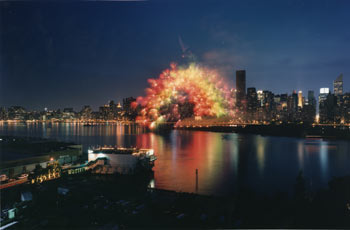
On view at the Guggenheim Museum in New York City from Friday, February 22 until May 28, Cai Guo-Qiang: I Want to Believe surveys the innovative body of work of this Season 3 featured artist. The exhibition charts his distinctive visual and conceptual language across four mediums: gunpowder drawings, explosion events, installations, and social projects. With more than 80 works from the 1980s to the present, this show establishes Cai’s influence as a creator of socially-provocative projects for large audiences. Designed as a site-specific presentation, this comprehensive retrospective is the museum‚Äôs first solo show devoted to a Chinese-born artist.
Following its New York opening, the exhibition is expected to travel to the National Art Museum of China in Beijing, as a part of the cultural Olympiad during the Olympic Games in August 2008. It will also be presented at the Guggenheim Museum Bilbao in spring 2009.
Cai Guo-Qiang was first exhibited by the Guggenheim in 1996, when he was selected as a finalist for the inaugural Hugo Boss Prize. The installation work he presented, Cry Dragon/Cry Wolf: The Ark of Genghis Khan, currently installed as part of the retrospective, is a highlight of the Guggenheim’s contemporary art collection.
“Cai Guo-Qiang has literally exploded the accepted parameters of art making in our time,” says co-curator and Guggenheim Foundation director Thomas Krens. “He draws freely from ancient mythology, military history, Taoist cosmology, Maoist revolutionary tactics, Buddhist philosophy, pyrotechnic technology, Chinese medicine, and methods of terrorist violence.” Co-curator Alexandra Monroe adds, “His expanded notion of cultural experience subverts tropes like East versus West, traditional versus contemporary, center versus periphery, suggesting a new cultural paradigm for the art of a global age.”
A number of public programs complement the exhibition. The first takes place Friday night at 7pm and will be a conversation between Cai and the show’s curators. A book signing by the artist follows the program. Read more info here.
See installation images and a video on the exhibition’s website.



